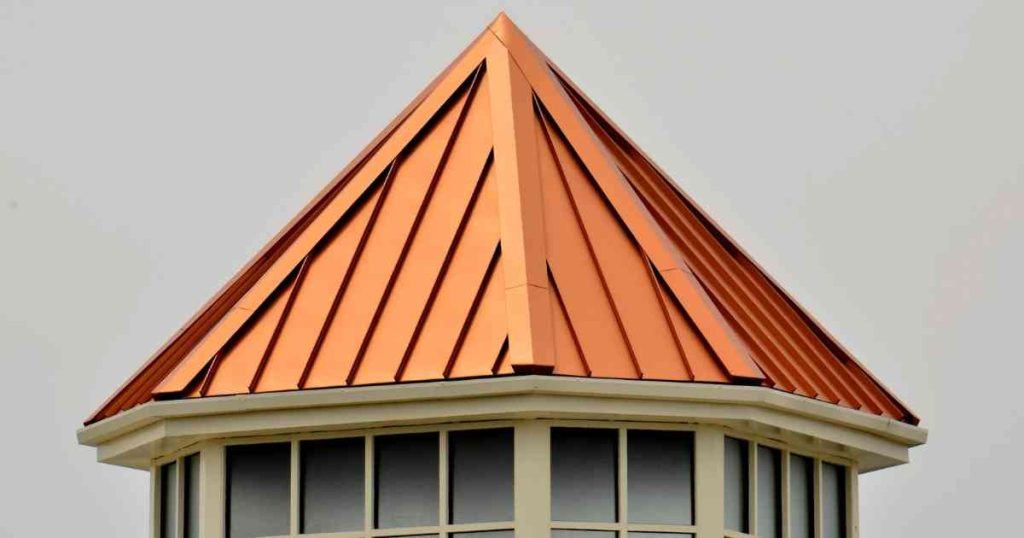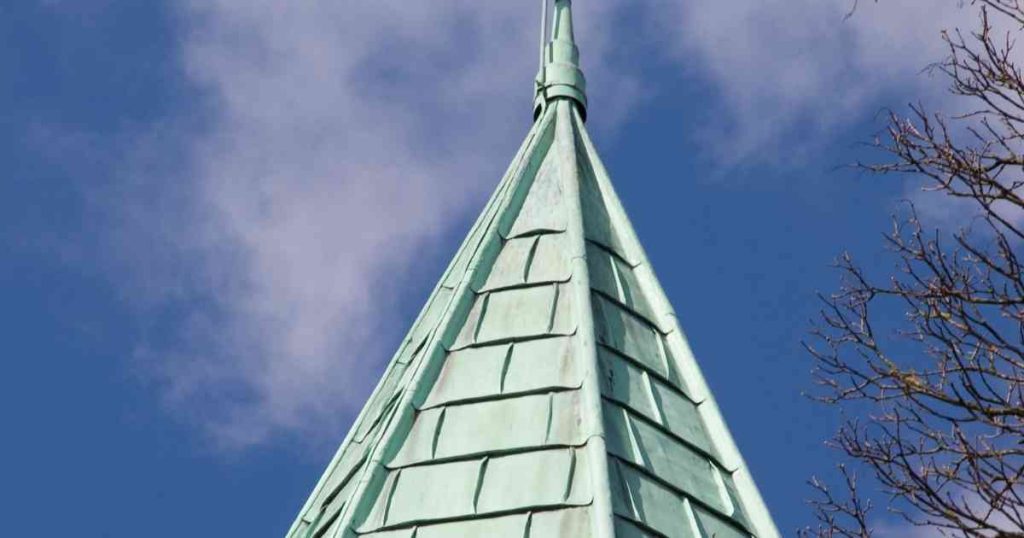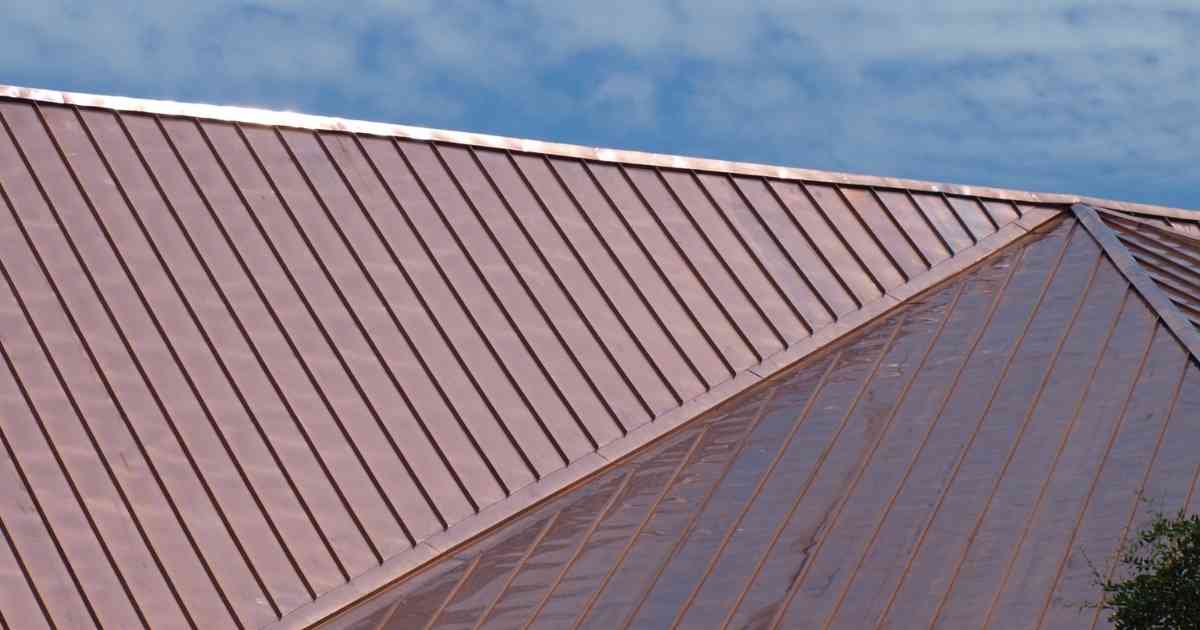The roof is an essential part of any building, and a good roof needs to be durable enough to survive for years even through harsh weather conditions. A few important components of a roof keep it intact and make it more durable.
Almost all roofs except flat ones use a ridge cap at their apex. This ridge cap protects the roof from snow and rain and cools the attic with ventilation.
Copper is a beautiful metal that adds durability and style to roofs. Let’s explore how the copper ridge cap adds durability to copper roofs.
What Is a Ridge Cap?

As the name suggests, a ridge cap is a cap or a cover that goes on the ridge of any sloped roof. Traditional sloped roofs have two sides that meet each other at the apex of the roof, and this apex is called a ridge or ridge line.
The ridge cap fits at the top of these ridge lines for added protection and style. It is attached by tightly sealed joints that exist on both sides of the slope.
If you have a shingled roof, you’ll need a durable ridge cap thicker than the shingle itself and already bent into shape. The ridge cap has to be thick because it needs to be durable enough to face harsh weather conditions and prevent damage.
The Importance of Ridge Caps
In addition to style, you also need favorable living conditions. Ridge caps complete the look of any home with added durability.
Ridge caps create a vent for hot air to escape without letting water enter your home. This ventilation is achieved with a heightened and inverted “V” or “U” shaped ridge cap with hollow space inside it that allows air to escape and water to slide away.
The apex of any sloped roof is the most sensitive and vital part, as it holds both slopes together. The joining of these slopes at the top adds to the risk of having small hollow spaces that could allow water to pass through.
Hence, to make the roof more durable, a good-quality ridge cap must be installed on it. Some ridge caps use mesh screens, which can help keep unwanted elements like bugs and pests from entering the house.
Another considerable advantage of ridge caps is that they allow for proper air circulation through the house. The constant exchange of outer and inner air makes the environment comfortable and reduces the need to use heating or cooling appliances.
If you want to install a ridge cap on your roof, this video guide can help you immensely.
Types of Ridge Caps
Engineering has evolved a lot over the years, and the construction of modern homes now focuses on quality while still ensuring an optimal living experience. To provide effective ventilation with added protection to the roof, ridge caps have also advanced a lot.
There are many types of ridge caps out there that vary in terms of materials and the designs used. The two major types of ridge caps are solid closures and vented closures.
Solid closures are airtight ridge caps, and they are useful for situations that do not require any sort of ventilation. Vented closures are more popular because they have a small gap for ventilation.
As far as materials are concerned, it’s recommended that you use the same material for your ridge cap that you used for your roof. For example, if you have a copper roof, you should use a copper ridge cap.
As for designs, there are many types. Let’s look at some of them.
Edge Ridge Cap
This ridge cap design has two slopes that reach up and form a flat apex, providing a watertight membrane. It has a robust and sturdy structure that provides long-lasting durability.
Ellis Ridge Cap
This ridge cap is unique in style and is engineered for good ventilation. The slopes of Ellis ridge caps meet a step before the apex and join each other at a round top.
Hi Ball Ridge Cap
A Hi Ball ridge cap has a modern shape that consists of slopes that are curved inwards and reach towards the top where they meet a round-shaped apex. This design is a good choice regarding looks and practicality, as it is unique in style and the rounded apex adds to the ventilation.
Point Ridge Cap
The diamond-like top of this ridge cap adds an elegant yet sturdy look to the roof. Point ridge caps have a unique design. The top looks like a diamond, which allows for increased ventilation.
Rollick Ridge Cap
These ridge caps have a rounded and heightened apex. The slopes travel vertically upwards towards the top and join a round-shaped peak. This design can add style to your roof with good water resistance and ventilation.
Standard Hip Ridge Cap
A standard hip ridge cap has a massive round apex that can provide adequate ventilation. The slopes of this ridge cap lead straight to the apex and meet there.
Straight Ridge Cap

This is the most straightforward design of a ridge cap. Straight ridge caps appear like an inverted “V” with two slopes going straight and meeting a pointed arrow-like apex at the top. The standard ridge cap is the oldest ridge cap design.
Tempo Ridge Cap
This waterproof design has a very narrow and tall dome-like top, which is ideal for good water resistance with added ventilation.
Copper Ridge Caps

Metal roofs have been popular for ages due to their durability and accessible design. Copper is one of the most robust choices for construction, and it is commonly used as roofing shingles or sheets.
As we discussed, you should use a ridge cap made out of the same material that your roof is made out of.
The most significant benefit of using copper as a ridge cap is that this metal can be easily turned into any shape or style without compromising its quality. As copper is a good insulator, using this material would lower the cooling costs of any home.
Copper has been a significant material in the history of construction and buildings. Many buildings have copper installed in them that has lasted for hundreds of years.
Many metals corrode over time, but copper gets a protective patina layer on it with time. Patina is a phenomenon whereby a blue-green coat forms over copper due to oxidation. The green color of the Statue of Liberty is due to patina formation.
Another benefit of using copper for your roofs is that it is not vulnerable to hot or cold temperatures and can easily tolerate every season all year round. Copper is a highly sustainable material that can be used for longer durations with less maintenance.
Copper roofs can be easily cleaned and will shine good as new, whereas clay roofs will fade in color and are not as easy to clean as copper.
A survey carried out by the German Ministry for Environmental Affairs in 2004 stated that the lifespan of copper is up to 200 years, whereas the lifespan of stainless steel and aluminum is 100 years.
Use of Copper in Construction
Copper has earned recognition in the fields of construction and architecture. It is used in various architectural elements, including chimney caps, awnings, and domes.
Copper gained popularity in architecture due to its durability and flawless appearance. Plus, this metal is also flexible enough to be turned into any desired shape, and it is corrosion-resistant.
A distinguished quality of copper is that it portrays a wide range of hues, from black to greenish patina colors. Because of this, many architects have been drawn to copper.
Some of the greatest architects ever employed copper in their projects. One famous architect, Frank Lloyd Wright (who designed more than 1000 structures over the span of 70 years), used copper in all of his projects.
Some of the most notable architectural projects incorporated the use of copper. Vasa Museum in Stockholm, Sweden is a prominent structure that was built using 12,000 square meters of copper cladding.
Another example of the artistic use of copper is Frank O. Gehry’s enormous and beautiful copper fish sculpture in Vila Olimpica, Barcelona.
Final Words
The use of copper dates back to the early 1400s when many architects used this metal for building solid and sturdy roofs. In addition to buildings, copper was also used in the structure of ships to make them more durable.
Some added benefits of copper include its ability to be molded into various shapes and styles and its durability.
If you have a copper roof, you should be using a copper ridge cap because the roof and the ridge cap should be made out of the same material for reasonable adjustment and durability. Copper ridge caps provide good ventilation and block the entrance of unwanted elements.
